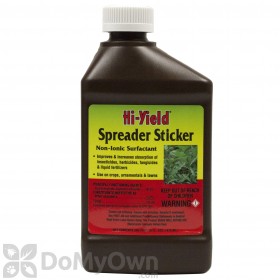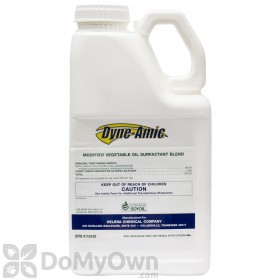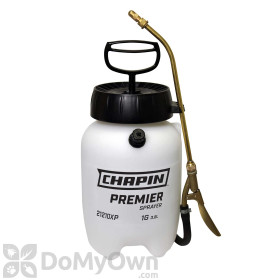
Have you ever used an herbicide, fungicide, or insecticide on a plant, only to see it bead up and roll off the plant leaves? Did your plant health product seem less than effective? You may need a surfactant.
The waxy cuticle present on most plant leaves can be hard to penetrate, causing liquids to roll right off. This can waste product and limit the effectiveness of the treatment unless a surfactant is used.
Surfactants, also referred to as wetting agents or spreader stickers, help your liquid lawn and garden products adhere to, or "wet", the foliage they are sprayed on, ensuring you get the most out of the products. Learn more about surfactants, why they are needed, and how to use one by reading below
What is a Surfactant and Why Do I Need One?

A surfactant is a chemical compound that lowers the surface tension between a liquid and a gas, solid, or other liquid.
To get scientific, surfactants have molecules that are both attracted to water (hydrophilic) and repelled by water (hydrophobic). The combination of both help the surfactant stay on a waxy surface.
By lowering this surface tension, liquid will not roll off surfaces as easily, but will instead spread and stay on the surface to which they are applied.

Plants like shrubs, edibles, ornamentals, and weeds naturally have a waxy cuticle on their leaves. On some plants this cuticle is more noticeable than on others. Due to this cuticle, liquids bead and roll off the leaves or beads of liquid sit on leaves without spreading or penetrating, defeating the purpose of an herbicide or insecticide.
When applying an insecticide, herbicide, or fungicide to your plant, you want to prevent your liquid chemical from rolling off the plant leaves, as that will be a waste of product and money and will not help the plant. Surfactants help the chemical stick to the plant, penetrating the waxy cuticle to allow the plant to absorb the chemical and increase the product's effectiveness.
Surfactants are not meant to be used on their own, as they often do not have any effect on plants one way or another by themselves.
Types of Surfactants

There are several variations of surfactants available. Read the label of your herbicide, insecticide, or fungicide to determine what type of surfactant you will need for your application.
Non-ionic surfactants - Non-ionic surfactants are neutral, meaning they have neither a positive nor a negative charge. Non-ionic surfactants are popular as surfactants as their neutral charge reduces the chance of having a reaction with the chemicals they are mixed with.
Methylated seed oils - Also known as MSOs, methylated seed oils help penetrate waxy cuticles and reduce the evaporation of a product. MSOs are soy based, then put through a methylization process to become a surfactant.
Oil concentrates - Oil concentrates use specialty oils like paraffinic oil or orange oil combined with surfactants. The oil helps the surfactant interact and mix with certain chemicals and may be advertised to be used with insecticides, fertilizers, or fungicides. Be sure to read the product label to be sure your product can be mixed with an oil concentrate.
Built-In surfactants - Many products formulated to be used on plants, like herbicides, will include a surfactant in their bottle. This eliminates the need to purchase and use an additional surfactant, one less product and step to worry about in your lawn care.
Pro Tip
Some people recommend using dish soap, vinegar, and other household products as an alternative to using a surfactant. Others even recommend "washing your lawn" with soap and water before applying an insecticide or herbicide.
DO NOT DO THIS! The chemistry of dish soap and other household items may interfere with the chemistry of your herbicide, fungicide, or insecticide to reduce the effectiveness of your product. The combination may also burn your plants. Dish soap has not been tested for use on plants and is not labeled to be used with lawn care products, therefore we cannot recommend that you use it in your lawn care program.
How-To Use Surfactants
Before applying any liquid product to your plant, read the product label. When reading the label, look for the following:
- Is this product safe to use on my plant?
- How much product should be used on my plant?
- Is a surfactant needed or is there already surfactant mixed with my product?
- How much surfactant is needed?
Once you have determined that the product can be used on your plant and that a surfactant is needed, you can mix your product. Some labels will simply mention the need for a surfactant but will not give measurements. In that instance, refer to the label of your surfactant.
Mix the product with water in a hand pump or backpack sprayer according to the product label's instructions. Add your surfactant in as well, then shake the sprayer (with the cap on) to agitate and thoroughly combine the solution.
Then, apply your product and surfactant mixture according to the label.
Pro Tip
Surfactants can burn plants in extreme heat. Read the label of your surfactant for temperature suggestions. Apply product mixed with surfactant early in the morning when it is cooler, allowing the product time to dry before the full heat of the day.
Shop DoMyOwn's selection of surfactants.
For more information about surfactants and help selecting one, give our customer service team a call at 866-581-7378 or email [email protected].















